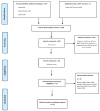Beyond the BMI: Validity and Practicality of Postpartum Body Composition Assessment Methods during Lactation: A Scoping Review
- PMID: 35683995
- PMCID: PMC9182963
- DOI: 10.3390/nu14112197
Beyond the BMI: Validity and Practicality of Postpartum Body Composition Assessment Methods during Lactation: A Scoping Review
Abstract
The assessment of body composition during lactation is an important indicator of maternal nutritional status, which is central to the overall health of the mother and child. The lactating woman's nutritional status potentially impacts on breastmilk composition and the process of lactation itself. The purpose of this scoping review was to synthesize comparative studies that sought to validate various body composition assessment techniques for use in lactating women in the postpartum period. Using the PRISMA-ScR guidelines, a comprehensive, systematic literature search was conducted using Scopus, Web of Science, and PubMed. Eight comparative studies were included in the review, with data from 320 postpartum women. The design methodologies varied substantially across studies, and included a range of simple techniques to advanced multi-compartment models for assessing body composition. The validity and reliability of measurement tools must be considered alongside issues of safety, practicality, and appropriateness to guide the research design when applied to lactating women.
Keywords: anthropometry; breastfeeding; lactation; maternal body composition; maternal nutrition.
Conflict of interest statement
The authors declare no conflict of interest. The funders had no role in the design of the study; in the collection, analyses, or interpretation of data; in the writing of the manuscript, or in the decision to publish the results.
Figures
Similar articles
-
Effects of Breastfeeding on Maternal Body Composition in Moroccan Lactating Women during Twelve Months after Birth Using Stable Isotopic Dilution Technique.Nutrients. 2021 Jan 4;13(1):146. doi: 10.3390/nu13010146. Nutrients. 2021. PMID: 33406595 Free PMC article.
-
Food insecurity, but not HIV-infection status, is associated with adverse changes in body composition during lactation in Ugandan women of mixed HIV status.Am J Clin Nutr. 2017 Feb;105(2):361-368. doi: 10.3945/ajcn.116.142513. Epub 2017 Jan 4. Am J Clin Nutr. 2017. PMID: 28052888 Free PMC article.
-
Factors related to duration of postpartum amenorrhoea among USA women with prolonged lactation.J Biosoc Sci. 1994 Oct;26(4):517-27. doi: 10.1017/s0021932000021647. J Biosoc Sci. 1994. PMID: 7983102
-
Breast-feeding and family planning: a review of the relationships between breast-feeding and family planning.Am J Clin Nutr. 1982 Jan;35(1):162-71. doi: 10.1093/ajcn/35.1.162. Am J Clin Nutr. 1982. PMID: 7039292 Review.
-
Maternal Nutrition and Human Milk Nutrients: A Scoping Review.MCN Am J Matern Child Nurs. 2025 Jan-Feb 01;50(1):9-17. doi: 10.1097/NMC.0000000000001059. Epub 2024 Dec 3. MCN Am J Matern Child Nurs. 2025. PMID: 39623537
Cited by
-
The Effect of BMI on Blood Lipids and Dyslipidemia in Lactating Women.Nutrients. 2022 Dec 5;14(23):5174. doi: 10.3390/nu14235174. Nutrients. 2022. PMID: 36501203 Free PMC article.
-
The Prospective Applications of Bioelectrical Impedance Analysis in Postpartum Women.J Clin Med. 2025 Feb 10;14(4):1126. doi: 10.3390/jcm14041126. J Clin Med. 2025. PMID: 40004657 Free PMC article. Review.
References
Publication types
MeSH terms
LinkOut - more resources
Full Text Sources
Medical


